Output Tracking via Adaptive Backstepping Higher Order Integral Sliding Mode for Uncertain Nonlinear Systems
Abstract
The authors propose a new tracking control design strategy for uncertain non-linear systems which are convertible to Semi-Strict Feedback Form (SSFF). The system in SSFF is first converted into new variables via existing adaptive backstepping control techniques. The control law is obtained by combining adaptive backstepping procedure and higher order integral sliding mode. The component of control law designed via backstepping is continuous which shows robustness against parametric uncertainties where as the discontinuous control component provides robustness against unmodeled dynamics and external disturbances. Since, this strategy relies on an integral manifold of the adaptively developed variables, therefore, the reaching phase is eliminated in this approach, which is an advantage in term of robustness. Furthermore, the parameters update law correctly provides the estimation of parameters which is again results in enhanced robustness of the strategy. The stability of proposed method is analysed theoretically and validated through a numerical example.
1. Introduction
The design process of nonlinear feedback control system is quite complex and challenging. Major concern is to design a controller that guaranties some specific behaviour of the system and is robust against unmodeled dynamics, parametric uncertainties, and external disturbances. There are no specific methods or set of analysis and design tools that can fit universally for wide range of situations and applications. However several tools are available which are generally applied to control nonlinear feedback system to achieve desired regulation or output tracking.
Sliding mode control (SMC) reported by [1, 2] is well known for its ability to compensate the external disturbance, unmodeled dynamics, and parametric uncertainties satisfying matching conditions. The classical SMC suffers from high frequency control switching the chattering phenomenon that severely damages the actuators and the system. Another limitation of this method is that it can only be applied to the systems of relative degree one. Relative degree is the relationship of output to the input of the system. The relative degree number is the count of derivatives of the output variable on which input variable appears. In the system which satisfies 01 relative degree condition, on taking first derivative of the output variable, input variable appears in the equation. Many physical systems, such as mechanical systems and satellite control system, do not satisfy 01 relative degree condition. The need of the relative degree one and chattering reduction/elimination was handled via different techniques (see, e.g., [3–5]).
A systematic design procedure that resolves the issue of relative degree is the backstepping algorithm [6] and it is suitable for feedback linearisable systems [7–9]. This is essentially a recursive design methodology in which a virtual control is designed at each step until an actual control law is realized. Conventional feedback linearisation method [3] has a drawback in the sense that this requires a precise model around some specific equilibrium points where some useful nonlinearities responsible for stability may disappear. However, the backstepping method avoids wasteful cancellations to achieve the global stability and to improve the performance.
Sira-Ramirez et al. [10] have combined the fundamental adaptive backstepping algorithm [11] with dynamically input-output linearization technique [7]. The blended method was extended in combination with the SMC, for those systems which can be transformed into triangular, Parametric Pure Feedback Form (PPFF) or Parametric Strict Feedback Form (PSFF) (see, e.g., [12–14]). Furthermore, some interesting SMC based techniques were put forwarded by, for example, [15–17] for nonlinear systems which are transferable into semistrict feedback form (SSFF) suffering from unmodeled and unmatched uncertainties. In this way, the benefit of SMC and adaptive backstepping were realised. An additional benefit is that the requirement of transformation into PPFF or PSFF and the justification of extra conditions on parameters and sufficient condition for the existence of sliding mode [14] were not needed. Recently, Khan et al. [18] reported strategy of dynamic control for MIMO uncertain, square, and minimum phase nonlinear system based on integral sliding mode technique. This method has synthesized dynamic sliding mode control [19, 20] and integral sliding mode strategies [1] into dynamically integral sliding mode control (DISMC) which provided the establishment of sliding mode without reaching phase. In this way the robustness against uncertainties is enhanced and performance is improved with considerable attenuation in the chattering across the integral manifold.
Fascinated by the strategy of DISMC, the authors have combined the adaptive backstepping and Higher Order Integral Sliding Mode Control (HOISMC) (see, e.g., [21, 22]) into a new technique named Adaptive Backstepping Higher Order Integral Sliding Mode Control (ABHOISMC); this will provide robustness from the initial time instant against parametric uncertainty along with considerable reduction in chattering. This newly proposed technique is developed for Single Input Single Output (SISO) nonlinear systems which are transferable into SSFF in the presence of some unknown parameters. The design process involves the subdivision of the control law into two parts, continuous control law which can be realized by applying adaptive backstepping method and discontinuous control law which is developed via an integral manifold. The parameter update law is also a sum of two terms. The first term emerges from the adaptive backstepping method and the second term is the contribution of the HOISMC. The remainder of the paper is managed as follows: the problem description/formulation is presented in Section 2, the development of the control law is explained in Section 3, an illustrative example is presented in Section 4, and the conclusions are drawn in Section 5.
2. Preliminaries
2.1. System Description
It is required that the output y of the system should follow a specific bounded desired continuous signal yd(t).
Assumption 1. It is assumed that the nth order time derivatives of yd exist and are bounded in nature. In addition, it is assumed that the scalar nonlinear functions ηi(ζ, ω, t), i = 1, …, n. are bounded by known positive functions; that is,
2.2. Adaptive Backstepping Design Approach Development
In this study, a generalised recursive approach analogous to that of [13] is presented for the tracking of a time varying signal yd(t). The step by step development is given as follows.
2.2.1. Step 1
Consider a new variable which represents the error between the actual output of the system and the desired output in the following form:
2.2.2. Step 2
2.2.3. Step k (1 ≤ k ≤ n − 1)
The variable zk is defined as .
2.2.4. Step n
Note that, zn is the variable whose time derivative bears explicitly the actual control input u. In the next section, the control input is developed.
3. Control Design via Higher Integral Sliding Mode
In this study, which is the main contribution, a control design for the nonlinear systems convertible into SSFF is considered. The design is carried out by making use of first order and second order adaptive backstepping integral sliding mode control which are discussed in detail in forthcoming subsections.
3.1. Control Design via First Integral Sliding Mode
3.1.1. Design of the Adaptive Backstepping Controller u0
The development of the continuous control component is presented in the form of the following proposition.
Proposition 2. Consider that the nonlinear system with new variables [z1, z2, …, zn] exists, if a control law is chosen in the following form:
Proof. Consider a Lyapunov candidate function of the form
Note that the update law mentioned in (30) is the first components of (28). In the forthcoming subsection, the design of the discontinuous term via integral sliding mode is presented.
3.1.2. The Design of the Discontinuous Component u1 ∈ ℜ of (27)
Theorem 3. Consider the transformed system with the state vector z = [z1, z2, …, zn] T. If the integral manifold is defined according to (33), the integral dynamics is chosen according to the following equation:
Proof. We consider the Lyapunov function of the form
Therefore, the above expression reduces to the following form:
Thus,
Note that the parameter update law which appears before (40) is the second component of the parameter update law in (28). The algebraic sum of the two parameter update laws gives birth to the final expression of the parameters update law.
3.2. Second Order Adaptive Integral Sliding Mode Control Design (SOAISM)
Note that the parameter update law in this case bears the first component of (28) because the higher order sliding manifold contributes nothing to parameter update law. In the subsequent illustrative examples, the switching manifold and chattering reduction claim is verified. The parameter update law in this case becomes τ = θ0 because σ = 0 is justified from t = 0.
4. Illustrative Example
The above example is simulated with the control law and parameter update laws defined above. The tracking of the yd = 0.05sin(2πt) is shown in Figure 1 which indicates that the time varying signals can be tracked very accurately in presence of uncertainties shown in Figure 7. The first order integral manifold displayed in Figure 3 ensures the sliding mode enforcement from the very beginning and, consequently, ensures robustness. The respective control input and parameter estimates are shown in Figures 4 and 2, respectively. Thus it is clear from these figures that the control input is appearing with reduced chattering.
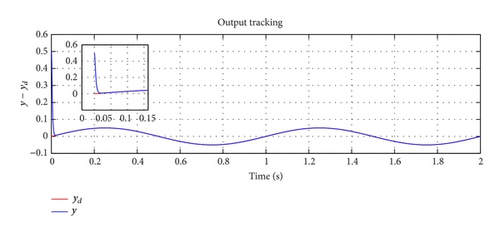
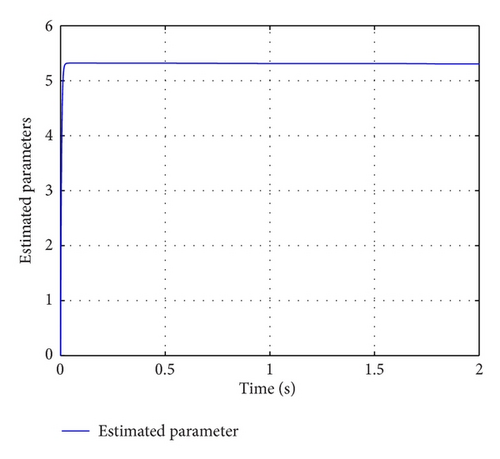
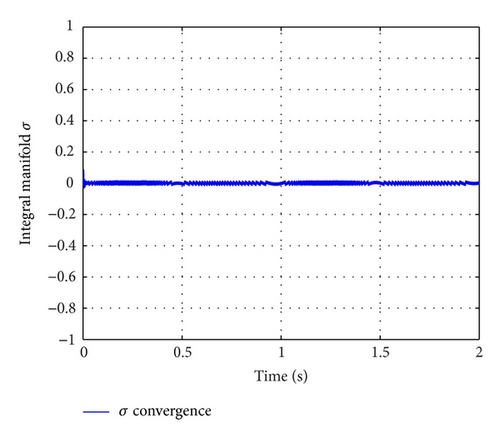
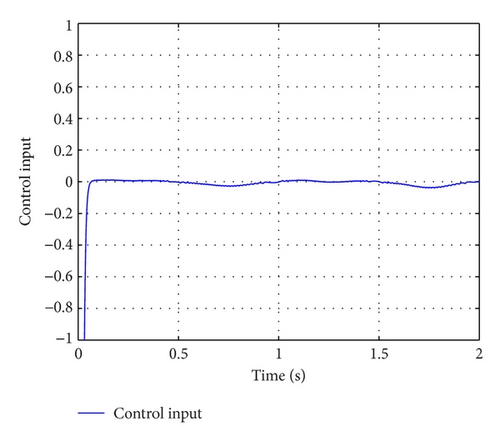
The AHOISMC results of tracking are somewhat similar to that reported in Figure 1. Therefore, it is not displayed here. The clear advantage comes in the chattering reduction which is clear from Figures 3 and 6 comparison. That higher order sliding mode with adaptation provides almost chatter free control input. The sliding manifold convergence of this strategy is displayed in Figure 5. In addition, the phase trajectory of is given in Figure 6 which, once again, shows the establishment of higher order sliding modes from the very beginning. This is a clear advantage of this proposed technique over the existing adaptive sliding modes techniques. The parameters used in simulation results are ϵ = 1.997, a = 0.7, k = 30, k1 = 1, c1 = 200, and c2 = 140, λ = 0.1.
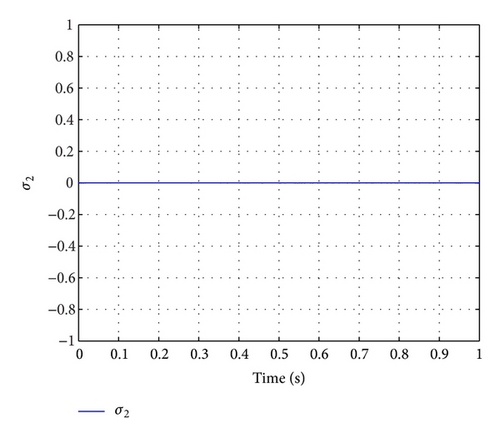
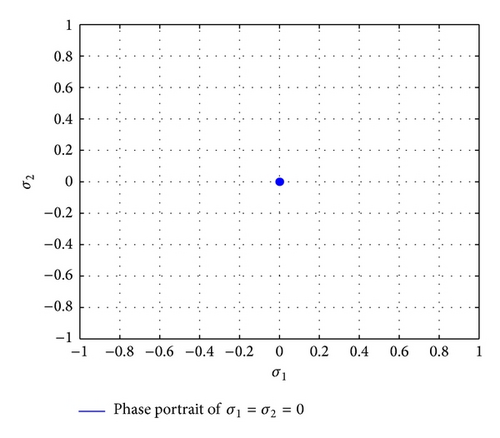
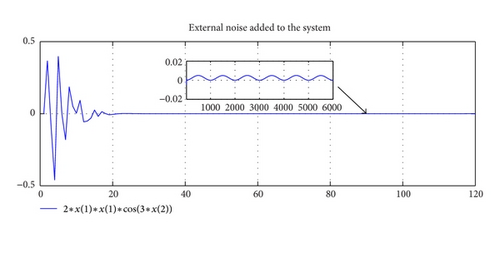
From the aforementioned discussions of figures, it is verified that our new proposed techniques provide robustness from the very beginning via the integral manifold approach and the robustness against parametric variations is provided via adaptive backstepping. It is therefore claimed that the above development outshines the existing adaptive sliding mode techniques.
Comment. Proposed design technique is recursive; therefore it is costly in computation and complex due to complex mathematical derivations. Thus its computational cost is relatively higher than adaptive sliding mode. However beauty of this method is that its control action is global and robust.
5. Conclusion
The backstepping technique which is famous for its robust nature against parameter variation is utilized in combination with integral higher order sliding mode control strategy in order to enhance the robustness of the system from the very beginning of the process with considerable attenuation in chattering. The approach is relying on an adaptively developed new system. The integral manifold is designed in the new state variables. In other words, the manifold is adaptive in nature because of the adaptively developed states variable. The control law is designed via higher order integral sliding mode with adaptation which is capable of providing robustness against uncertainties caused by external/internal disturbances. The stability analysis is elaborated in terms of a proposition and a theorem. A numerical simulation result has verified the design approach.
Conflict of Interests
The authors declare that there is no conflict of interests regarding the publication of this paper.




